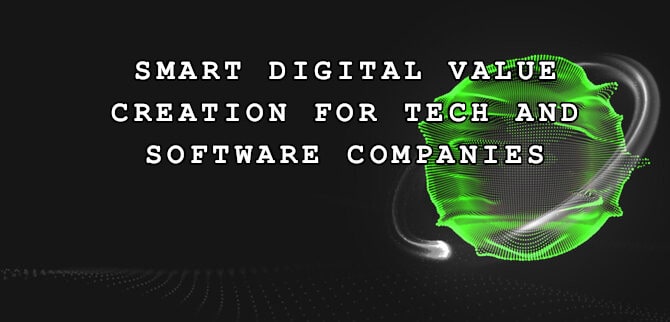
07 Feb Smart Digital Value Creation for Tech and Software Companies
We can never let our infatuation with technology obscure the fact that it’s just a tool. A tool we use to build value. My top-down value creation approach always starts with, what value do we want to create? Then, what data do we need to create that value? And lastly, what tech is required to capture and transform that data into value? If you start with choosing the technology you want to deploy, it’s like the tail wagging the dog. It is only after we’ve figured out what we want to build that we start looing for the tools to do so.
Smart digital transformation can be applied to any company, but the type of company determines the specific tools needed to implement the smart digital transformation.
At a high level, smart tech value creation is architected with an AI or analytics model at its core. This model is nourished and matured with data and is wrapped in software with be executed as a sim (simulation) to provide value. If that’s not high level enough, consider my definition of smart digital transformation: The transformation of a company into a software-defined and data-driven company. Let’s remember that definition for later.
Because we build digital value in different ways based on company type it’s useful to classify companies along a digital continuum:
Traditional Companies -> Tech Companies -> Software Companies
Traditional companies create value in the physical world. They use tech for sure but not as a defining part of their product, service or environment. The first step in their transformation then is to virtualize value creation into what is called a digital twin. At the heart of the digital twin (and there can be many twins) is the AI or analytics model. For traditional companies picture this: There is the physical product and beside it is its digital twin. The digital twin, which is software-defined and data-driven is a living simulation of how the physical product creates value, tethered to the physical world by data collected by its sensors.
Tech companies, like traditional companies, also create value in the physical world except their products are more computerized. Although tech products are more likely to include software as a main component, they’re generally not software-defined, and unlikely to be data-driven. So they too are transformed to employ an AI model fed by sensors and executed by software to create value. In other words, however computerized, they too need to be virtualized with a digital twin.
Software companies (intentionally differentiated from tech companies) create value in the virtual world, operating in computing devices or a whole bunch of computing devices in data centers (the cloud). They are already virtualized, so by definition, are software defined. But most software products are not data-driven like Netflix, Amazon or Google. Since software products are already digital, a digital twin is not needed but its functionality is. To do this we re-architect the software to incorporate value sims for value creation and “listeners” to feed them data. Listener routines can be thought of as virtual sensors. Instead of transforming the physics, chemistry or biology of the physical world into data, these listeners connect with internal data structures or to external data services on the internet.
Smart digital transformation can be applied to any company, but the type of company determines the specific tools needed to implement the smart digital transformation.
HOW IT’S DONE
In the case of traditional companies and tech companies, a sim software structure is developed to overlay or add on to the product (service, operation, environment) and its data, collected by sensors in the physical world, are transported to the simulation on the internet of things. The sim is executed “in” the product to create value but in reality it may be computed locally, on the network fabric or in the cloud.
In the case of software companies, the software product is re-architected to incorporate value sim(s) that are connect to listener routines, internal data structures and external services, to collect data.
For all company types the AI or analytics model used in the digital twin or digital twin facsimile is developed and refined outside of the product. This is done with a data pipeline to fetch and format data from a database and to then feed it through AI or analytics routines to improve and mature the model.
Contact us if you’d like to understand more or click calendar to schedule a free 30-minute consultation if you have a company to improve.







